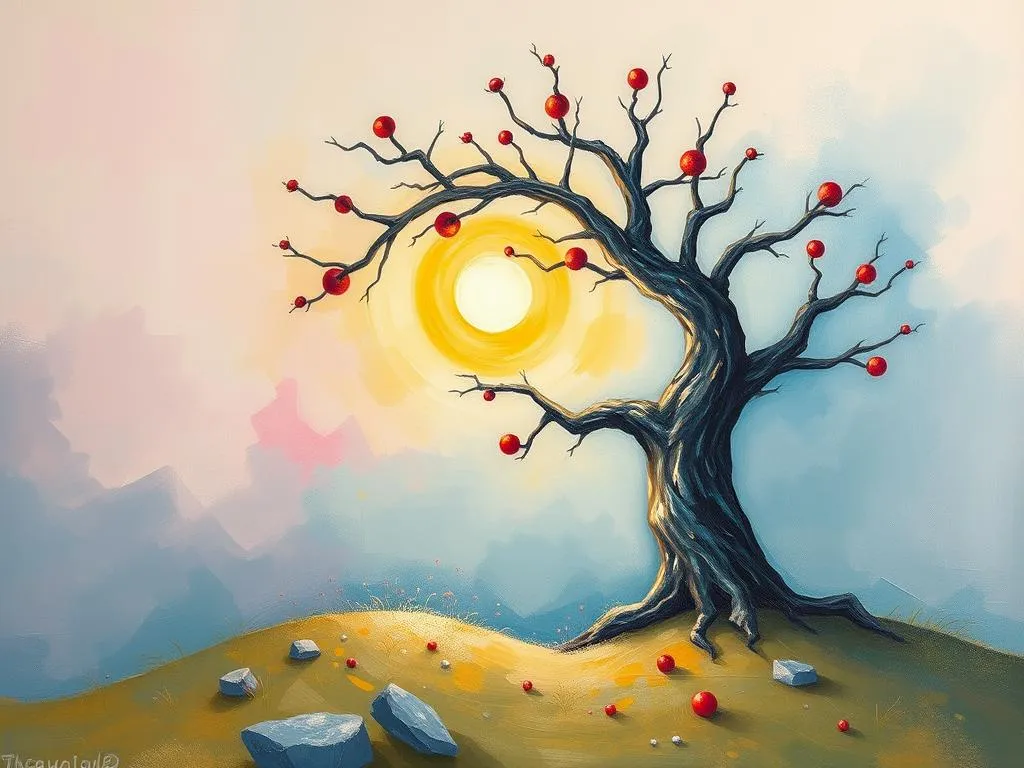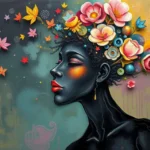
Dreams have long been a source of fascination and inquiry, often providing a window into our subconscious minds. Among the myriad symbols that can manifest during sleep, the thorny tree stands out as a particularly potent image. This dream symbol intrigues many due to its multifaceted interpretations and the complex emotions it can evoke. In this article, we will explore the symbolism and meaning behind the thorny tree, examine key scenarios and variations of this dream, and provide insights on how these dreams can connect to our waking lives.
Symbolism and Meaning
The thorny tree in dreams can represent a variety of themes and emotions, often linked to both the positive and negative aspects of life. On one hand, trees are generally symbols of growth, stability, and fertility. They can embody the potential for new beginnings and the strength to endure life’s challenges. However, the presence of thorns introduces a contrasting element that suggests pain, struggle, and obstacles.
When interpreting a dream featuring a thorny tree, it is essential to consider the feelings associated with the image. For instance, if the dreamer feels fear or anxiety while encountering the thorny tree, it may symbolize a current struggle or a source of emotional pain in their waking life. This could relate to a difficult relationship, a challenging work situation, or personal insecurities that feel insurmountable.
Conversely, if the dreamer approaches the thorny tree with curiosity or determination, it could represent a willingness to confront challenges and grow from them. This perspective highlights the duality of the thorny tree—while it may represent hardships, it also symbolizes the potential for personal growth through overcoming adversity.
In different cultural contexts, trees can hold various meanings. In some traditions, trees are seen as sacred and a connection to the divine. The thorns might then indicate a necessary sacrifice or the trials one must endure on their spiritual journey. In other interpretations, the thorny tree could symbolize defense mechanisms—how one protects themselves from emotional pain or the fear of vulnerability.
Ultimately, the thorny tree serves as a powerful metaphor for the complex nature of human experience. It invites dreamers to confront their struggles while also reminding them of the resilience they possess.
Key Scenarios and Variations
The context of the thorny tree within a dream can significantly alter its interpretation. Here are some common scenarios that might occur:
-
Climbing the Thorny Tree: If the dreamer finds themselves climbing the tree, this may indicate a desire to overcome obstacles in their life. Climbing suggests ambition and the pursuit of goals, while the thorns represent the challenges that must be faced along the way. This scenario encourages the dreamer to assess their current ambitions and recognize the potential barriers that may need to be navigated.
-
Being Pricked by Thorns: A dream in which the dreamer is pricked or hurt by the thorns can symbolize emotional pain or betrayal. This scenario may reflect feelings of vulnerability or a recent experience where the dreamer felt hurt by someone close to them. It serves as a reminder to acknowledge and process these feelings rather than suppressing them.
-
Admiring the Thorny Tree from a Distance: If the dreamer observes the thorny tree from afar, it may indicate a fear of confronting certain issues in their life. This scenario often suggests avoidance or reluctance to engage with something that feels overwhelming. The tree’s thorns serve as a warning, urging the dreamer to assess what they are avoiding and why.
-
Harvesting Fruit from the Thorny Tree: In a more positive light, if the dreamer is able to harvest fruit from the thorny tree, it may symbolize the rewards that come from facing challenges. This scenario emphasizes that while struggles can be painful, they can also lead to fruitful outcomes. It encourages the dreamer to view their challenges as opportunities for growth and acknowledge the strength they gain from overcoming difficulties.
-
Walking Under the Thorny Tree: This dream scenario may evoke feelings of anxiety or tension. Walking under a thorny tree can represent navigating a difficult situation in life, where the dreamer feels exposed to potential harm or criticism. This image calls for self-reflection on current circumstances and encourages the dreamer to seek shelter or protection from emotional turmoil.
Each of these scenarios provides a unique lens through which to view the thorny tree’s symbolism. By considering the specific context of the dream, individuals can gain deeper insights into their emotional landscape and the challenges they face.
Real-Life Connections and Takeaways
Understanding the symbolism of the thorny tree and its various dream scenarios can help individuals connect their dreams to real-life situations. By engaging in self-reflection, dreamers can uncover valuable insights about their emotional state, relationships, and personal challenges.
One practical approach to reflect on dreams involving thorny trees is to keep a dream journal. Recording details about the dream—such as feelings, colors, and actions—can help the dreamer identify patterns and themes that recur in their waking life. This practice fosters a deeper understanding of how subconscious thoughts and emotions manifest during sleep.
Another beneficial exercise is to identify current life situations that resonate with the feelings evoked by the dream. For example, if a dreamer experienced anxiety about the thorny tree, they might explore areas in their life where they feel overwhelmed or threatened. By acknowledging these feelings, the dreamer can begin to address them, whether through communication, seeking support, or developing coping strategies.
Moreover, the thorny tree can serve as a powerful metaphor for resilience. Just as a tree endures various seasons and weather conditions, individuals can draw strength from their experiences, both positive and negative. Embracing the challenges symbolized by the thorns can lead to personal growth and empowerment.
It’s also essential to consider the role of support systems in navigating the difficulties represented by the thorny tree. Sharing dream experiences with trusted friends or family can help illuminate hidden feelings and provide new perspectives on challenges. Encouraging open dialogue about emotions can foster connections and create a sense of community.
In conclusion, the thorny tree is a rich and complex symbol in dream interpretation that invites individuals to explore their struggles and vulnerabilities. By reflecting on the various scenarios and personal emotions associated with this dream symbol, one can uncover valuable insights that resonate with their waking life. Embrace the journey of self-discovery, and remember that every thorny path can lead to profound personal growth and resilience.







